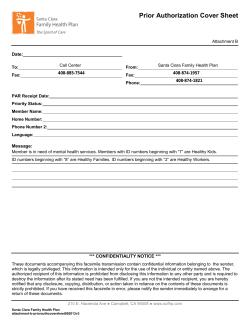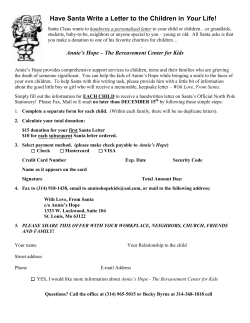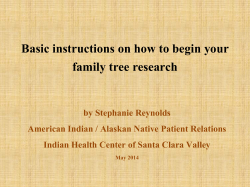
Sample only Cantigas de Santa Maria of Alfonso X, el Sabio
Sample Only – Not for re-use Cantigas de Santa Maria of Alfonso X, el Sabio A Performing Edition Volume 1 - Prologo to CSM 100 Sample only This document contains the Preface, Introduction, bibliography and CSM 0, 1, 2, 9 & 10 only. For the complete edition contact the author at c_elmes@hotmail.com OR www.btinternet.com/~gaita Preface I recently completed a set of transcriptions of the Cantigas d'amigo by Martin Codax and the Llibre Vermell as I felt that there was no readily available set of transcriptions of either group of songs and wanted to fill that gap. I have been persuaded that there is also a gap in transcriptions of the Cantigas de Santa Maria. The only complete edition is that of Anglés (3 volumes with facsimile and commentary) but it is not in print, is prohibitively expensive if it can be found, and is found in very few libraries. This is my attempt to present the Cantigas in an affordable published form to those interested in performing more than the handful of transcriptions readily available. This booklet covers the first 101 cantigas from the Prologue to CSM 100. The numbering and most transcriptions are based on the Escorial manuscript (E1); the same basis used by Anglés in his edition. Time and energy permitting I hope to produce another three volumes of approximately 100 transcriptions to complete the set of over 400 cantigas from E1. I have produced these transcriptions as a performer and for other performers. It is not intended to be a Critical Edition nor a work of exhaustive scholarship. As a performer I do not feel tied to one musical theory concerning the cantiga notation or period style and I believe performers are in the best position to explore different approaches to performance. This approach can be open to extremes but, if we keep in mind a clear distinction between what is known and what is speculation, then it is also useful tool for questioning (and supporting) conventional thinking. Sample Only – Not for re-use 1 Sample Only – Not for re-use The transcriptions of melodies and texts are taken from the facsimiles of the manuscripts. These facsimiles have been made available to a wider public thanks to Greg Lindahl who has created a website with scans from the Anglés edition of E1 and the Ribera edition of To. (and to many other links). Many thanks to him for providing the resources allowing me to get started. Chris Elmes Edinburgh, 2004 Permission is given to use these musical transcriptions as a basis for performance or recordings on the condition that the author’s contribution is clearly identified for each performance or recording. © 2004 by Gaïta. All rights reserved Chris Elmes Gaïta 1f2, 25 Haddington Place Edinburgh c_elmes@hotmail.com www.btinternet.com/~gaita Sample Only – Not for re-use 2 Sample Only – Not for re-use Contents Preface................................................................................................................................... 1 Introduction ........................................................................................................................... 4 The Cantigas de Santa Maria.............................................................................................. 4 The Transcriptions ............................................................................................................. 4 The Texts ........................................................................................................................... 6 The Cantigas .......................................................................................................................... 7 List of Incipits...................................................................................................................... 15 Cross-reference of E1 with To. ............................................................................................. 16 Select Bibliography.............................................................................................................. 18 Manuscripts ..................................................................................................................... 18 Facsimiles and Editions.................................................................................................... 18 Translations ..................................................................................................................... 18 Musical Studies................................................................................................................ 18 Sample Only – Not for re-use 3 Sample Only – Not for re-use Introduction The Cantigas de Santa Maria The Cantigas de Santa Maria are a group of over 400 songs praising, and recounting miracles performed by, the Virgin Mary. These have been preserved in four remarkable manuscripts dating from c.1270-84. They were compiled under the patronage of Alfonso X, el Sabio (the Wise), king of Castille and León and are written in Galician-Portuguese, the literary language of the court of Alfonso. The Prologue, CSM 1 and every tenth cantiga is a song of praise to the Virgin Mary or Cantiga de Loor. All the others narrate the miracles associated with Mary. There are also two small groups of cantigas added later called the Cantigas das Fiestas de Santa Maria and Cantigas das Festas de Nostro Sennor. The Transcriptions No one as yet has put forward a generally accepted theory explaining the notation system used in the cantigas manuscripts. The complete edition by Anglés remains the benchmark both for academics and performers and is by far the most common source for performance – not surprising as it currently is the only complete source of transcriptions. More recently Ferreira, van der Werf and Cunningham have written on the subject with a more systematic approach. Of the three, only Cunningham has applied his ideas to create commercially available transcriptions and he has only covered the cantigas de loor (40 in all) but, in my opinion, his approach does not always produce viable and satisfying results. Following Anglés I have used the Escorial manuscript (E1) as the basis of the set of transcriptions. Ferreira argues, quite convincingly, that the Toledo manuscript (To.) is the earlier and more accurate but as it contains only around 120 of the cantigas I have decided to use the more complete source and use To. as a cross-reference. This collection is not meant to be an authoritative edition. I have decided to take a pragmatic approach and have tried to give transcriptions of all cantigas that balance ‘performability’ with an attempt to stay as close as possible to the set of literal values for the symbols in the manuscript that I have outlined below. There is also the matter of producing a musically satisfying result. This raises the thorny issue of whether “musically satisfying” to the modern ear is a valid gauge for transcriptions of medieval music. Inevitably there will be an element of subjectivity in any transcription of medieval music and, though I would love to reproduce medieval music as it was performed originally, we can never really know what it was like. We can use what information we have but the music is filtered through our own perceptions and ultimately through those of our audiences. A number of different approaches have been used to produce these transcriptions and sometimes two similarly notated cantigas have been transcribed with different rhythms (cf. CSM 10 and 41). I do not assume that all the cantigas are in some form of ternary rhythm. I have explored the possibilities for binary rhythms and larger groupings of rhythms more common outside the closed world of Parisian music theory of the medieval period.1 Some of the cantigas clearly are in a modal rhythm (see below) but very few adhere strictly to the rules. Even where a song clearly starts in a modal rhythm there are often irregularities in heading towards cadences. In many of the cantigas I have assumed, like Anglés, that the notation is basically mensural (each note or ligature has a fixed duration irrespective of context) but, unlike Anglés, have accepted that there are some ambiguous symbols. I have interpreted these symbols flexibly where I feel it would otherwise break the flow of the melody, but the flow may not necessarily follow an even rhythm. Much of the difficulty in understanding the rhythm of the cantigas I believe stems from the 1 Some possibilities are discussed by Ferreira in ‘Andalusian Music and the Cantigas de Santa Maria’. Sample Only – Not for re-use 4 Sample Only – Not for re-use possibility that uneven, or irregular, rhythms were present but without a notation system suited to recording them. Rhythmic Modes 1st e.g. CSM 21 (with occasional 2nd) | ||… |||… | . | . | … | . | . | … | . | . | . | . | … | | |… 2nd 3rd 4th 5th 6th e.g. CSM 8 e.g. CSM 17 In effect the 4th and 5th modes are not used in the cantigas and the 6th used only rarely. Other rhythmic patterns used in transcriptions Binary | ¦ | … or | | … e.g. CSM 25, 26 3+2 |||… e.g. CSM 5, 10 3+3+2+2 | ¦ ¦ ¦ |… e.g. CSM 9 3+3+2+2+3+3 | ¦ ¦ ¦ ¦ ¦ |… e.g. CSM 15 (variant in note) Most of the cantigas seem to be in some form of ternary or binary rhythm with ‘building blocks’ of long and short notes or ligatures (longs or L, and breves or B). These blocks can be further subdivided (breves can be divided into semibreves or S) but for rhythmic purposes L and B are the basic elements. L can be thought of as 2 tempora (or beats) and B as one. A ‘perfection’ is a group of three tempora, e.g. LB or BL. L can also be ‘perfected’, that is, increased to a value of 3 tempora (indicated as L+). The one-note and most of the two-note symbols have a clear mensural value. Below is a table with the values I have assumed for most of the ligatures used in the manuscripts in terms of duration – L or B. L 1 25 26 a f B 2 5 6 e k h ?? b g ?? b g The problems occur mostly with the value of b and g which appear to be used inconsistently between cantigas for both L and B, though they usually have the same value within a particular cantiga. In some cantigas they seem to be used indiscriminately (and possibly interchangeably) with a and f. My initial assumptions when transcribing b and g is to assign them a value of B though as often as not in the finished transcription they are given as L. Three-note ligatures are generally transcribed as L or perfected to L+. My initial assumptions were: L L+ . I J B D X Q G H A C W R Sample Only – Not for re-use 5 Sample Only – Not for re-use The actual value of the component notes of a ligature is also a matter of conjecture. For example, many different ligatures are used for 3 falling notes – it is probable that they were performed in contrasting ways, e.g. , , . Practically it is not of great importance; the flow and pulse of the melody remains the same. The choice is largely a matter of performance style and taste. Generally, plicated ligatures (rising or falling stem on the right side) are transcribed as a quaver with stroke through the stem and subtracts its value from the previous note, e.g. 5 = . The performance of plicated ligatures 25 and 26 is another open question. These have been transcribed as B-B with a cross bar on the stem of the lesser note, eg . They could be . or ; again it is matter of taste and context. Where a cantiga naturally falls into ternary rhythm (with little use of perfection on longs) I generally have adopted it and have looked no further for other rhythmic solutions. These ternary rhythms are usually a mix of 1st and 2nd mode rhythms. In other cases, perfection has not always been applied to longs where, by not doing so, it produces a regular rhythm on a larger scale than those available to modal rhythms – usually mixtures of 3 and 2, e.g. 3+2, 3+3+2+2. Occasionally there appears to be no regular rhythm that fits the notation so I have given these in an unmeasured transcription. Where there appear to be other rhythmic options I have given notes as to possible other interpretations. Generally, I have not followed the practice of alteration (altering the length of the second of a pair breves followed by a longa to make the pair of breves a perfection, eg BBL becomes |BL| L+|) except when transcribing a melody into 3rd mode. As far as I can see, if you assume a ternary rhythm, using a combination of perfection and alteration allows any tune to be wedged into any of the modal rhythms, and therefore it is of no use to justify a choice of rhythm. While trying to remain as close as possible to the manuscript occasionally I have changed explicit note values where these have an analogous note elsewhere in the cantiga or where the rhythm in To. implies the change. I have noted these in each cantiga. For a few cantigas I have used To. as the basis where it seems to have a clearer indication of the rhythm. The Texts The texts given with the transcriptions are literal readings of the first stanzas in E1 and allowances must be made for my limited knowledge of palaeography and Old Galician-Portuguese. I have made no attempt to edit these apart from expanding scribal shorthand notations, e.g. per, que, nn, deus. I have given sources for complete editions of the lyrics and translations in the bibliography. Often the full texts are also available on the internet – the best way to find them is to search on the first two or three words. Sample Only – Not for re-use 6 Sample Only – Not for re-use The Cantigas Prologo – Por que trobar e cousa 25 2 P Por que tro 1 2 1 ( ? a f k /k k k k k /k j 25 - 2 P - 25 ten - di - 2 P e cou - sa - o 1 2 1j per que en 1 2 1j af j af j o 21 men - to po - ren que - no faz k k k /k k k k k /k j k - 2 1 1 e ra - zon as - saz, 1j 1 j ben tro - bar Jk j 2k 1j - bi 1 j que en - ten - de de 2 1 de 2k 1 ten - da'e sa 2 j 1| k kk j j k j ver 1j k a f k /k k j ca - iaz 1| 1 d'a en que 2 P a f k /k k k k k /k j a k k k j 2 2 26 a f k /k k k k k /k j en 2 j 1| j k j bar 1 1 2 1 - a di 2 1 k j di - zer lle 2 1 % 2 J as - si s'a de ffa k j 1| k k k j j - " zer kkk k praz, 1| kkkk k kkk j - zer. This piece is an introduction to the collection of songs in praise of, and miracles about, the Virgin. It is unusual in the cantigas because it is through-composed in the manner often used by the troubadours (the only other through-composed cantiga in the first 100 is CSM 1). A rhythmically free interpretation stressing the lyrics would appear to be justified. Sample Only – Not for re-use 7 Sample Only – Not for re-use Cantiga 1 – Des oge mais 2 1 ( a ( ?) k 1 \\ ge mais j - 1 b po - la Se 2 1 1 g \\ en que Deus quis 2 1 1 b 1 \\ - j ak j j quer 26 25 nnor on eu - - car - ne e sa 1g - b por nos dar gran sol 2 1 1 g \\ 2 U no seu Rey no e nos por - 1 \\ de vi X da per Sample Only – Not for re-use da, k k jz - da 2 k k k jz er - dar 1 \\ - na k jz - da 2 2 1 k k k k k 8 1 \\ 1g mas 2 jz 1 \\ da 25 sa k - - k k k /k j z de jz - k j b j seus k 26g k /k k k k j 1 2 a k j j a k /k j 1 \\ gra 1 a k k /k k k 1 \\ fi - llar, k k k /k j z ta da, f k k k jz k j g 1 k k jz 2 25 5 1 \\ - U 2 ak j tro - bar rra 25 1 \\ k jz 26g k /k 2 k j j be - ey 2 k jz / k k k k k /k ak j ak 2 jz k Des o 2 2 - lon - ga jz - da, Sample Only – Not for re-use -1- 2 1 sen a 25 k /k j ak j 2 ak per 1 - ver 1 \\ jz mort' - 5 b 25 27 pois a pas k k k /k k /k j z mos 26 g - tra ve - gg k /k k /k k k ou 1 k k k k - ga - sar 1 j da. The first of the Cantigas de Loor in praise of the Virgin. These occur every tenth cantiga after the first (10, 20, etc.). Unusual in being throughcomposed song with no refrain . Both Anglés and Cunningham (and therefore nearly all performers) transcribe this cantiga in D mode with a B? throughout. E1 though has a ( clef (with no B?) except in the line in the manuscript ‘Deus quis carne fillar beeyta’ where it changes to ( ? and therefore should only effect the B at 3.6 and probably, by analogy, 6.6. To. has no occurrences of B?. It was acceptable medieval practice to flatten a B when it is between two As which covers most of the occurrences. Sample Only – Not for re-use 9 Sample Only – Not for re-use Cantiga 2 – Muito devemos Refrain (? 2 26 a 2 2 k afk k k k / k Mui - to B de - ve - mos, va 1 j 5 2 I lo - ar a San - ta Ma k k k f a 2 a - 5 k rõ - es, 1 k k k kkk / f 2\ k kkk j a 2 1 2\ j - ri k - a, g $ 26 4| et seus do - es k k k k k k k k k k k /k af k k k k / que sas gra - cas 1 2 25 5 2 g 1 da a quen por e - la fi af j k k k /k k k k / k Stanza 1 2 a af k k k j 5 g de bõ - a 1 2 25 5 que deu a un 2 a 1 j af k k k 1 af j et $ 26 - 2 2 g k 1 5 g j - $ - a. 2\ kk kkkkkk j / foi 5 d'Es 2 g ra cha - e - 10 k 2\ k pa - nna 1 j - 2\ la - do, 1 k k k /k k k k / Af - fons' Sample Only – Not for re-use seu pre ma - do 25 k ma - nna k k k /k k k k / k que pri j k k k k k k k k k /k k / Sen mui - ta af j 2\ 2\ k ma - do, Sample Only – Not for re-use -22 a 2 - a k k k f a que trou 2 - a 2 - a a tal 2 8a k kkk ves - ti - 1 2| j k du - ra 1 j 5 2 kk k kkk / 1 xe de pa - ra ý - so, f 7 2 ta a f 5 I - $ 2\ j k 1 2\ k k kk k kkkk j / af k k k ben feý 2 k /k k af k k k deull hú 26 ssa me g - k su - ra, $ 26 seu si 2\ k k k k k k k k k k k /k f k k k a k / por que me - te - ra 1 2 25 en a lo af j k 5 2 g 1 noý - t'e di k k k /k k k k / - ar - so 2\ j k - a. The first of the cantigas recounting miracles of the Virgin. If a ternary rhythm is implied in the notation, it appears to use the ligature g as S-S at 3.5, 5.5, 7.5 and 12.5, and as B-B at 4.6, 6.6, 8.6 and 13.6. Sample Only – Not for re-use 11 Sample Only – Not for re-use Cantiga 9 – Por que nos aiamos 1 Refrain 2 )?afj 2 af j k de - 1 afj que nos a re - nen 2 1 af j 2 f 2 1 b es - ta ci 2 1 af k j k j ouv' y mui 2 2 - hú - a 2 k 2 b k k k fa - ze - dor j 2 2 a fez Sample Only – Not for re-use cha - mos 1| tran - ça. 2 2 1 que vos ei ia di - ta, 1 2 2 k j k j 1 k k j mui san - ta ! de to - do k j 2 j 1 2 2 1 e de ben com j 12 j k /k j - d'al - gu'e no - bre 1| ! j e mui j 26 de - mos 2 j - 1 1 j 1 2 de 1 1| 1 j j ri - ca k j gran j 1| 1 di - a, k k j j 2 1 afk j j 1| 2 1 e k k k k 1| j f 2 b 1 do - na 1 2 1| da - de, 1 2 k k k j Do - mas a 1 - k j en k k k j Ma - ri 1 sem - pre, noit' j bran - ça, 2 j 1 j k k k k j En af j - 1 j 1| j la 1 1 1| ia - mos 1 k j San - ta Stanza - 2 1 k j que 1 k k k k j Por 1 2 b 1 j 1| j 1| j vi - da, 2 1 k j mal 1 j qui - ta, 26 1| k /k j k k j - pri - da. Sample Only – Not for re-use -9- 1 2 2 b Mas, por que sa 1 2 2 1 af j af j do 1 af j hú' k k - k j - 2 1 j j 2 k biá - mos co - mo 1 1 1| j k j 1 1| j k k k mun - do ga 2 1 j j 2 k 1 j non fez di f 1| 1 2 2 1 a, u fi - llou mo al - ber - ga - ri - k 1 k k j que - ri 1 j k k k co - mo j f 2 b ban - ça, k k k j 2 - - a 1| j ga - mos 26 1| k /k j k k j - ran - ça. This cantiga is given with a literal transcription (with unperfected long). The rhythm can be seen as phrases of 3+3+2+2. Sample Only – Not for re-use 13 Sample Only – Not for re-use Cantiga 10 – Rosa das rosas 1 k j Ro - sa das k j aj Do - na das a Stanza a j 2 1j j k 1 Ro - 1 2 1 2 1| ro e Fror das fro-res, - sa k j j sas 25 5 k /k k 2 1 1 B J\ kkk kkj 2 1 (aj Refrain /k j do - nas, Se - de bel - de pa - re - cer - zer, de k j j na en mui pi - a 25 5 k /k k 1 to j 2 26 / 1 | k k k j e 2 1 Se - nnor en 1 le 1 k j nno - res. j 2 1 aj - k k k k /k / 1 2 1 k k /k m 2 26 2 25 / 1 | k k k j 25 - m 1 Fror d'a 1 das se dad e e - nnor k j j 2 26 2 1 Do 2 1 k k k k /k / 25 1 aj 1 1 k j k j - 2 26 - gri - a k j /k j ller coi 85 2 26 1 | /k k k /k k k /k j - - pra do - 1 2 1 tas e do j k j sa se - er, k k /k m 2 26 | - o - res. This cantiga is normally given in 3rd rhythmic mode. This is a literal transcription which produces a 5/4 rhythm (7/4 at ends of phrases) or could be performed freely. To perform in 3rd mode lengthen the first note or ligature of each measure to L+. For the first line this would be: | . | | . | ()| Sample Only – Not for re-use 14 Sample Only – Not for re-use List of Incipits 86 65 68 51 89 4 83 6 67 82 13 96 55 41 42 91 45 8 97 79 49 73 23 53 80 77 58 1 40 94 70 60 61 56 34 33 19 11 24 3 37 52 57 22 36 2 87 99 30 29 98 27 50 26 78 93 75 35 12 84 25 14 81 85 38 18 46 43 9 *0 66 72 95 5 76 59 63 16 44 32 64 74 88 10 7 69 21 92 62 100 17 71 90 31 48 54 28 15 39 20 47 Acorrer nos pode e de mal guardar A creer devemos que todo pecado A Groriosa grandes faz A Madre de Deus devemos teer A Madre de Deus onrrada A Madre do que livrou Aos seus acomendados A que do bon rey Davi A Reýnna groriosa A Santa Maria mui bon servir faz Assi como Jesu-Cristo estand ena cruz Atal Sennor é bõa que faz salvalo pecador A tant e Santa Maria A Virgen, Madre de Nostro Sennor A Virgen mui groriosa Reya espirital A Virgen nos da saude tolle mal A Virgen Santa Maria tant e de gran piedade A Virgen Santa Maria todos a loar devemos A Virgen sempr’ acorrer acorrer Ay Santa Maria quen se per vos guya Ben com’ aos que van per mar Ben pod as cousas feas remosas tornar Como Deus fez vynno d’agua Como pod a Groriosa mui ben enfermos saar De graça chéa e damor Da que Deus mamou leite do seu peito De muitas guysas nos guarda de mal Des oge mais quer eu trobar Deus te salve groriosa Reya Maria De vergonna nos guardar Eno nome de Maria Entre ave Eva Fol é o que cuyda Gran dereit é de seer Gran dereit e que fill’o Gran poder a de mandar Gran sandece faz Macar ome per folia Madre de Deus non pod’ errar Mais nos faz Santa Maria Miragres fremosos faz por nos Santa Maria Mui gran dereit é das bestias Mui grandes noit e dia Mui gran poder á a Madre de Deus Muit’ amar devemos en nossas voontades Muito devemos varões Muito punna dos seus onrrar Muito sse deven téer Muito valvera mais, se Deus manpar Nas mentes senpre teer Non deva Santa Maria mercée pedir *0 = Prologo Sample Only – Not for re-use 15 Non devemos por maravilla teer Non deve null ome desto per ren dultar Non e gran cousa se sabe Non pode prender nunca Nulla enfermidade non é de sãar Omildade con pobreça O que a Santa Maria der algo ou prometer O que a Santa Maria mais despraz O que en Santa Maria Pagar ben pod o que dever Par Deus, muit’ é gran razon Par Deus tal sennor muito val Pera toller gran perfia Pois que Deus quis da Virgen fillo Por nos de dulta tirar Por que aian de seer Por que e Santa Maria Por que nos aiamos Porque trobar e cousa Quantos en Santa Maria Quem diz mal da Reýna Espirital Quen aos servos da Virgen Quen as coitas deste mundo Quen a sas figuras da Virgen partir Quena Virgen ben servir nunca podera falir Quen ben serv’ a Madre Quen dona fremosa e boa quiser amar Quen fiar na Madre do Salvador Quen loar podia com ela queria Quen mui ben quiser Quen Santa Maria quiser deffender Quen servir a Madre Rosa das rosas e Fror das frores Santa Maria amar Santa Maria os enfermos sãa Santa Maria pod’ enfermos guarir Santa Maria poder á Santa Maria sempros seus aiuda Santa Maria Stela do dia Sempre seia beeita e loada Se muito non amamos Sola fusti senlleira Tanto se Deus me perdon Tanto son da Groriosa Toda saude de Santa Reýa Todo logar mui ben pode sseer defendudo Todolos Santos que son Ceo Torto seria grand e desmesura Virga de Jesse Virgen Santa Maria guarda nos se te praz Sample Only – Not for re-use Cross-reference of E1 with To. To. E1 number E1 number Ribera’s number Codex number (0) 1 Prologo 1 2 2 To. Ribera’s number Codex number 31 33 XXXII I 32 35 XXXIV 3 II 33 36 XXXV 3 4 III 34 37 XXXVI 4 5 IV 35 93 XCII 5 20 XIX 36 38 XXXVII 6 6 V 37 40 XXXIX 7 7 VI 38 42 XLI 8 9 VIII 39 44 XLIII 9 10 IX 40 31 XXX 10 11 X 41 45 XLIV 11 12 XI 42 58 LVII 12 14 XIII 43 57 & 129 LVI 13 15 XIV 14 16 XV 15 34 XXXIII 44 59 LVIII 16 13 XII 45 84 LXXXIII 17 8 VII 46 60 LIX 18 17 XVI 47 62 LXI 19 19 XVIII 48 63 LXII 20 21 XX 49 64 LXIII 21 27 XXVI 50 61 LX 22 23 XXII 51 65 LXIV 23 24 XXIII 52 67 LXVI 24 18 XVII 53 68 LXVII 25 39 XXXVIII 54 70 LXIX 26 25 XXIV 55 87 LXXXVI 27 26 XXV 56 72 LXXI 28 28 XXVII 57 73 LXXII 29 30 XXIX 58 74 LXXIII 30 41 XL 59 76 LXXV Sample Only – Not for re-use 129 = no 57 from E2 16 Sample Only – Not for re-use E1 number To. E1 number Ribera’s number Codex number 60 71 LXX 61 48 62 To. Ribera’s number Codex number 82 117 V de otras XLVII 83 128 XIV de otras 50 XLIX 84 99 XCVIII 63 52 LI 85 - - 64 53 LII 86 29 XXVIII 65 89 LXXXVIII 87 22 XXI 66 79 LXXVIII 88 124 XI de otras 67 66 LXVI 89 125 XII de otras 68 69 LXVIII 90 - - 69 55 LIV 91 83 LXXXII 70 81 LXXX 92 86 LXXXV 71 92 XCI 93 - - 72 127 XIII de otras 94 32 XXXI 73 90 LXXXIX 95 - - 74 88 LXXXVII 96 - - 75 100 XLIX 97 120 VIII de otras 76 - - 98 95 XCIV 77 - - 99 - - 78 54 LIV 100 123 79 43 XLII X (sic) de loor 80 91 XC 81 49 XLVIII Sample Only – Not for re-use 17 Sample Only - not for re-use Select Bibliography Manuscripts Escorial Toledo E1 = ‘codice princeps’ = MS. b.I.2 = B.J.2 = j.b.2 E2 = ‘codice rico’ = MS. T.I.1 = T.J.1 = T.j.1 To. Biblioteca Nacional MS. 10 069 Facsimiles and Editions Anglés, Higinio, ed. La musica de las cantigas de Santa Maria del Rey Alfonso El Sabio, 3 vols (Barcelona, 1943-64) Volume 1 has complete facsimiles; volume 2 has transcriptions; volume 3 has commentaries. Cunningham, Martin G, Alfonso X, el Sabio, Cantigas de Loor, (UCD Press, Dublin 2000) ISBN 1 900621 31 2 Critical edition of Cantigas de Loor (as an arbitrary subset) with study of notation and text. Transcriptions, complete texts and translations of cantigas de loor. Mettmann, Walter, ed. Cantigas de Santa Maria, 4 vols (Coimbra: Acta Universitatis Conimbrigensis, 1959-72.) Reprinted 3 vols (Castalia, Madrid, 1984-89). Complete edition of the lyrics (no translations) The Cantigas de Santa Maria: Facsimilies. Maintained by Greg Lindahl at http://www.pbm.com/~lindahl/cantigas/facsimiles/ Complete facsimiles of all E1 cantigas taken from Anglés (see above) and all To. from Ribera. Translations Kulp-Hill, Kathleen, Songs of Holy Mary of Alfonso X, the Wise: A translation of the Cantigas de Santa Maria, Tempe, Arizona 2000 English prose translations of all cantigas in E1. Musical Studies Ferreira, Manuel Pedro, ‘Andalusian Music and the Cantigas de Santa Maria', in Cobras e Son. Papers from a Colloquium…, edited by Parkinson, Stephen (Oxford, Julho de 1994), Oxford: Legenda, forthcoming. Also maintained by Centro de Estudos de Sociologia e Estética Musical at http://www.fcsh.unl.pt/cesem/29_10_02/outraspublicacoes.html Ferreira, Manuel Pedro, 'Bases for Transcription: Gregorian Chant and the Notation of the Cantigas de Santa Maria', in Los Instrumentos del Pórtico de la Gloria: Su Reconstrucción y la Música de su Tiempo, Vol II, edited by José López-Calo (Fundación Pedro Barrié de la Maza, La Coruña, 1993.) ISBN 84-87819-72-9. Also maintained by Centro de Estudos de Sociologia e Estética Musical at http://www.fcsh.unl.pt/cesem/29_10_02/outraspublicacoes.html Sample Only - not for re-use 18 Sample Only - not for re-use Ferreira, Manuel Pedro, 'Iberian Monophony', in A Performer's Guide to Medieval Music, edited by Ross W. Duffin, (Indiana University Press, Bloominton and Indianapolis, 2000.) ISBN 0-253-33752-6 Van der Werf, Hendrik, ‘Accentuation and Duration in the Music of the Cantigas de Santa Maria’, in Studies on the Cantigas de Santa Maria: Art, Music and Poetry, edited by Israel J. Katz and John E. Keller, (The Hispanic Seminary of Medieval Studies, Madison, 1987). Sample Only - not for re-use 19
© Copyright 2025









